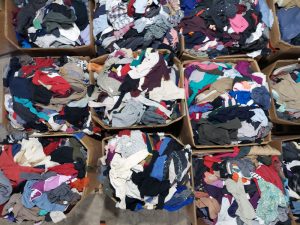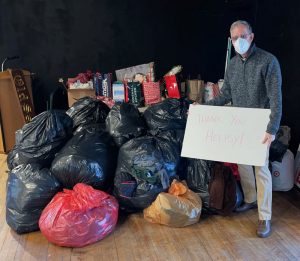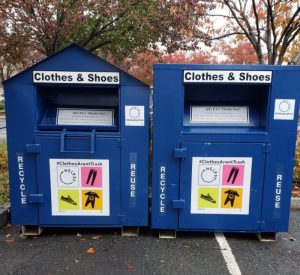 How HELPSY, the Largest Clothing Collector on the East Coast, Works
How HELPSY, the Largest Clothing Collector on the East Coast, Works
By Laura Johanson
What really happens to the clothes that are put into a HELPSY clothing collection bin, left curbside for a municipal partner pickup, or handed over during a clothing drive? It is a misconception that these items are given directly to the needy. HELPSY™ does provide clothing, coats and, on occasion, garment transportation to shelters, churches, and other relief organizations and partners with others to raise funds. The company’s ultimate objective, however, is not charity, but to preserve the environment. Textile waste is one of the fastest growing waste streams in the United States. By extending the useful life of clothing, HELPSY strives to keep unwanted textiles from becoming trash.
The Misconception
Reverend Nathan Ives, from St. Peter’s/San Pedro Church in Salem, Mass., understands the common misunderstanding associated with clothing collection. “As a former volunteer with the Red Cross, I’ve seen first-hand generous, but misguided people clean out their closets to offer piles of clothing after a natural disaster,” Father Nathan said. “The reality is, these well-intentioned donations result in a mountain of clothes that can’t be processed,” he said. St. Peter’s Church hosts a HELPSY clothing collection bin and earns a monthly rental check which is then used to fund community outreach programs. “I don’t know how HELPSY manages all that goes into collection, sorting and storage while still offering us a portion. This income goes toward our rental assistance programs, food assistance, and even to offer a laundromat-love gift card so someone in need can clean their own clothes,” he said.
 The church is not only a bin host but is also a recipient of donated coats through HELPSY. During the months of November, December and January, St. Peter’s Church switches gears, and offers a shopping event to the community offering FREE warm winter coats provided to them by HELPSY. “HELPSY has really gone out of its way to make this event possible again this year. We are expecting hundreds of coats to be delivered for our event,” Father Nathan said. “We have just enough storage to keep the coats left over until the next event. We would never have been able to collect and store these many coats without HELPSY.”
The church is not only a bin host but is also a recipient of donated coats through HELPSY. During the months of November, December and January, St. Peter’s Church switches gears, and offers a shopping event to the community offering FREE warm winter coats provided to them by HELPSY. “HELPSY has really gone out of its way to make this event possible again this year. We are expecting hundreds of coats to be delivered for our event,” Father Nathan said. “We have just enough storage to keep the coats left over until the next event. We would never have been able to collect and store these many coats without HELPSY.”
Clothing Surplus — The Challenge
While some organizations work toward meeting the need for emergency clothing or warm coats, there is still an abundance of unneeded and unwanted clothing ending up in landfills. One reason for this is the changing clothing industry. According to the EPA, since the beginning of the millennium, the amount of clothing manufactured has more than doubled from approximately 6 million tons in 2000 to 16 million tons in 2020. The business of creating trendy items at low cost, known as “fast fashion,” creates greater profits for the fashion industry and instant gratification to consumers. Unfortunately, this trend also leads to a shorter shelf life for clothing items and adds to the general disposable mentality that creates a surplus of outdated, worn, torn, or otherwise unwanted clothing items.
“The average person throws away more than 100 pounds of clothing every year,” said Dan Green, co-founder and CEO of HELPSY. “Only 15 percent of textiles are currently reused or recycled, while 95 percent of what winds up in landfills can be. HELPSY is working to change this lopsidedness. Recycling or otherwise reusing clothing can help save natural resources such as water and fuel and help to reduce toxins from pesticides,” he said.
While preservation of the environment is a noble mission, recycling is also an industry. HELPSY strives to balance profit and purpose… to use business as a force of good™. These efforts have earned them a Certified B Corp designation. HELPSY has also earned a Real Leaders Impact Award for 2020 and 2021 ranking as one of the top 150 impact companies solving business problems in socially constructive ways.
Through a combination of clothing drives, municipal partner curbside pickups, partnerships with thrift stores and clothing collection bins, HELPSY diverts nearly 30 million pounds of textiles from landfills every year. Working with organizations and various groups to collect these unwanted clothing and other items, HELPSY has also helped to raise more than $10 million for non-profits and other organizations while helping the environment.
“Recycled clothing aids in reducing waste in landfills, which is of great help to the environment,” said Fred Vineyard, State Commander, AMVETS Department of New Jersey. “However, AMVETS is most grateful for the funding received through our collaboration with HELPSY. It allows AMVETS to provide our services and to fulfill our mission,” he adds. In New Jersey, 548 AMVETS dedicated clothing collection bins in 226 different locations are serviced by HELPSY. The funds raised through these collection bins go to support AMVETS programs.
“At Helpsy we create win-win-wins,” said Dave Milliner, co-founder and COO of HELPSY. “The clothes you give away create jobs, save municipalities money that then gets passed to taxpayers and we help the environment.”
 What Happens to the Clothes?
What Happens to the Clothes?
Of the textiles that HELPSY collects, 95-percent are salvageable. Broken down further, 75 percent is reusable; and 20 percent is recyclable. Items collected are first sorted by HELPSY partners and divided into grades. The higher grades are resold to thrift partners in North America and other secondhand markets around the world. The lower grades go to industrial use or things like rags, stuffing, and insulation.
One such thrift partner is PossAbilities, a chain of thrift boutiques in Flemington and Phillipsburg, N.J. Danielle Crouse, area manager, takes pride in offering the local community quality and affordable secondhand merchandise. “Once our clothing and accessories are sorted and processed, they are neatly displayed by size in their appropriate department for easy browsing. This helps customers visualize the endless possibilities in giving fashion a new life.” HELPSY works with PossAbilities to manage their unwanted inventory items not sold in their boutique. These items are sorted and sent to both domestic and international resale markets. The remaining textiles, unfit to be re-worn, will be recycled, and turned into wiper cloths and fiberfill for furniture.
“While the situation is dire, there has been a shift in the perception of used clothing,” said Alex Husted, CFO and co-founder of HELPSY. “In 2020 there was a 27-percent increase in the sale of used clothing, coupled with a decrease in fast fashion manufacturing. Americans are on a trend toward more sustainable clothing,” he added.
HELPSY’s environmental mission is to radically change the way people think about clothing reuse and recycling. In the process of serving this mission, it has created jobs, saved municipalities millions of dollars in disposal fees and has reduced the enormous environmental burden of the second most polluting industry in the world. Considering those numbers, recycling clothes makes sense both environmentally and financially. For additional information about HELPSY or to join in our environmental preservation efforts, contact info@helpsy.co.
Editor’s Note: Laura Johanson is marketing/public relations manager for Helpsy™, White Plains, N.Y.
January 28, 2022




